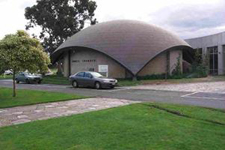Hobsons Bay City, comprising the suburbs of Altona, Laverton, Newport, Spotswood and Williamstown, is perhaps unique in the metropolitan area as a municipality that spans the period from the earliest settlement of Melbourne in the 1830s to the post-World War II expansion that significantly changed not only the physical boundaries of the city, but also its social and cultural life.
This case study examines how Victoria’s Framework of Historical Themes can be applied to a local government area using three key aspects of the historical development of the Hobsons Bay municipality. The case study demonstrates how places associated with the local history of Hobsons Bay fit within, and illustrate, state and national themes.
Victoria’s Framework of Historical Themes, in turn, reinforces the assessment of local significance of places at a local level and may highlight gaps and assist in the identification of new places. In addition it offers a contextual framework for identifying and assessing places that may also be significant at a state level.
Arriving and Migrating
The theme of migration is woven through the history of Hobsons Bay. It was the place where the first European settlers in the Port Phillip district landed in the 1830s, and as the major port serving Melbourne until the 1850s was the primary place of entry for many of the first settlers coming to the new colony. During the 1950s, many migrants came to live and work in the suburbs of Spotswood, Altona and Laverton.
Today, Hobsons Bay has one of the most culturally diverse populations in Melbourne.
The 19th century phase of Arriving and Migrating is represented by a wide range of grand buildings and features such as the former Customs House at Williamstown.
Erected in 1873-75 as the second customs house at Williamstown, this building reflects the important role of Williamstown as a major Melbourne port where large vessels were able to unload cargo and people in a deepwater harbour. The design by Peter Kerr represents Government architect William Wardell’s philosophy that public buildings should be as simple as possible, ‘so long as the architectural effect is preserved’, and represents the peak of architectural achievement of the Wardell years.
By comparison, the phase of post-war migration in the 20th century left less tangible evidence, and many places, such as migrant hostels, have already been lost. The Finnish Club, which occupies the former Red Robin Hosiery Factory, has survived.
The Red Robin factory was constructed in Pier Street, Altona, in 1949 and closed in the 1960s. In 1971 it was acquired by the Finnish Society, which was founded in 1958 in response to the large numbers of Finnish migrants who were arriving in Victoria at that time: membership grew from 98 in 1959 to 160 by 1962. A society member, Mrs Anneli Rickards, remembers that:
“The club made it possible to speak in Finnish and to share experiences in a new country.”
These two very different places are significant as an illustration of the long and continuing influence of migration upon the development of Victoria.
Victoria’s themes and sub-themes
2. Peopling Victoria’s places and landscapes
2.4 Arriving in a new land
2.5 Migrating and making a home
2.6 Maintaining distinctive cultures
Creating a centre of industry
Industry was attracted to this area from late 19th century onwards, attracted by the flat land and access to rail and port facilities. In 1922, Australia’s first oil refinery was established near Kororoit Creek and in 1949 the Vacuum Oil Refinery came on stream at Altona. This massive complex, which is still in operation today, was initially developed from 1949-55 and attracted many other industries such as Australian Carbon Black (now Cabot Australia) to locate here, forming what probably was Australia’s most important conglomerate of petrochemical industries.
The companies operated independently, but were able to take advantage of being located close to each other in obtaining raw materials and sharing some services.
The significance of industrial heritage, especially post-war industry, is sometimes overlooked or not well understood, particularly when sites are considered in isolation.
The application of Victoria’s Framework of Historical Themes confirms the local significance of the Altona refinery complex and indicates that it may also be significant at a state or National level.
Victoria’s themes and sub-themes
5. Building Victoria’s industries and workforce
5.1 Processing raw materials
5.2 Developing a manufacturing capacity
5.7 Working
Suburban expansion and forming local government
The suburbs of Altona and Laverton originally formed part of the Shire of Wyndham (later Werribee) from its formation in 1864. The influx of industry and significant population growth in the 1950s led to the creation of the Shire of Altona in 1957, with the Altona homestead (constructed in the 1840s and once owned by pastoralist Alfred Langhorne) serving as temporary municipal offices.
The young council quickly gained a reputation for its modern and progressive outlook, and this was reflected in the striking design of its new council chambers which opened in 1963. Designed by architect Robert Warren in accordance with a brief that specified ‘a spherical shaped metal-clad roof’, the building was a symbol of ‘Victoria’s most progressive community’, which was announced on a neon sign erected by the Council on Millers Road. The council building was described in 1968 as a ‘cinnamon dome (that) sits like a flying saucer come to rest’ by a real estate agent who concluded that ‘For a shire that came into existence only 11 years ago (Altona) has remarkable momentum.’
Altona was declared a city just five years later in 1968, and the Shire Offices are significant as an illustration of the rapid growth of Melbourne at that time and as a fine example of post-war architecture.
Victoria’s themes and sub-themes:
6. Building towns, cities and the garden state
6.1 Creating Melbourne
7. Governing Victorians
7.1 Developing institutions of self-government and democracy
Downloadable case study – Hobsons Bay City Council (PDF 186 KB)


